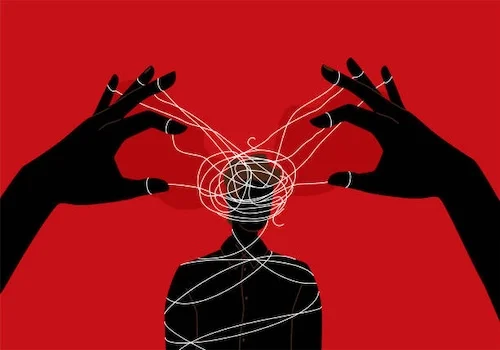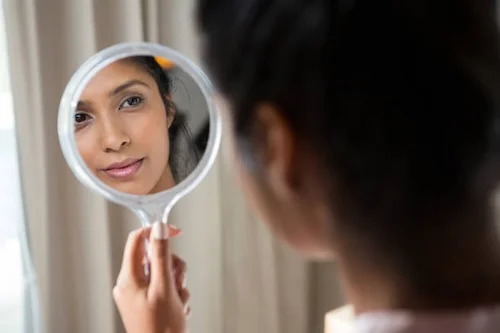When was the last time you went 24 hours without touching your phone?
How did it feel? Liberating? Maybe Terrifying?
Now here’s the real question – do you ever feel those phantom vibrations haunting your pocket?
Your phone isn’t just a device. It’s become a portal – a gateway that tunes you into specific frequencies of existence. Every endless scroll adjusts your internal dial, shifting your energy, emotions, and sense of self in ways you might not even realize.
But here’s the question nobody’s asking: What frequency are you tuned into right now?
Some portals lead to connection, creativity, and growth. Others trap us in cycles of comparison, depletion, and disconnection from our authentic selves.
The same device that can facilitate mental health education and meaningful relationships can also drain our life force, hijack our emotions, and distort our self-image beyond recognition.
We carry these portals everywhere, checking them over 100 times (or more) a day. They’re the first thing we see in the morning, the last thing we touch at night.
The cost? We’re witnessing an epidemic of digital exhaustion. People feel simultaneously overstimulated and understimulated, hyperconnected yet profoundly lonely, informed yet confused.
Our devices promise to enhance our lives, but for many, they’re creating a reality that feels increasingly unlivable.
At AlignUs, our mental health platform recognizes that true wellness in the 21st century requires a new kind of literacy – digital hygiene that protects not just our data, but our energy, emotions, and essence.
Our Device – The Invisible Influence Guiding Our Lives
Do you ever notice that “bone-deep” exhaustion despite getting eight hours of sleep? Or maybe you feel wired-but-tired every day.
It’s a mental fog that makes focusing feel like swimming through molasses.
Welcome to the age of digital energy depletion.
The Always-On Energy Vampire
Your smartphone doesn’t just consume battery life – it consumes yours. The always-on nature of modern devices creates a state of constant vigilance that our nervous systems were never designed to maintain.
Every notification triggers a micro-stress response. Your body doesn’t distinguish between a text message and a tiger – both activate your fight-or-flight system. Multiply this by hundreds of daily interruptions, and you’re marinating in stress hormones from dawn to midnight.
This constant connectivity fractures more than just your attention. It fragments your very life force, scattering your mental energy across dozens of open tabs and never-ending information streams.
No wonder you feel drained by noon despite barely moving from your desk.
The Attention Economy’s Hidden Tax
Tech companies have weaponized psychology to capture and monetize your attention. Every app is engineered to be irresistible, using the same psychological principles that make slot machines addictive.
The result? A phenomenon researchers call “continuous partial attention” – a state where you’re always partially focused on multiple streams of information but never fully present to any single experience.
This mental juggling act doesn’t just make you less productive. It fundamentally depletes your cognitive reserves.
Is Your Screen Sabotaging Your Sleep?
Perhaps nowhere is the energy drain of technology more evident than in our collective sleep crisis. The blue light emitted by screens suppresses melatonin production, tricking your brain into thinking it’s perpetual daytime.
Poor digital habits create a vicious cycle: disrupted sleep leads to depleted energy, which leads to increased screen time seeking stimulation, which further disrupts sleep. Many people now exist in a perpetual state of jet lag without ever leaving their time zone.
Beyond mental fatigue, our devices exact a physical toll. Hours hunched over screens create what physical therapists now call “tech neck.” Eye strain from screen exposure has become so common that it has its own acronym: CVS (Computer Vision Syndrome).
These aren’t just minor inconveniences. Mental health education rarely addresses these physical aspects of digital wellness, yet they profoundly impact our overall energy and wellbeing.
Reclaiming Your Energy
Understanding how technology drains your energy is the first step toward reclaiming it. This isn’t about becoming a digital hermit – it’s about conscious consumption.
Social emotional learning in our era must include understanding the relationship between screen time and energy levels.
We need mental health curriculum that teaches not just emotional regulation, but energetic regulation in a digital context.
The good news is that small changes create significant results. Taking regular screen breaks, using night mode after sunset, and creating phone-free zones can dramatically improve your energy levels.
The portal of your phone can drain you or sustain you – the choice lies in how consciously you use it.
Emotional Puppeteering
Check your phone after posting something. Refresh.
Check again. Still no likes. Refresh.
One like. Dopamine hit. Refresh.
Three more. Higher high. Refresh.
Comments rolling in. Validation starts flooding your system.
Welcome to the emotional tech rollercoaster. Today, algorithms have more influence over your mood than almost anything else in your life.
The Validation Addiction Cycle
Social media platforms have turned human connection into a slot machine. Every notification releases dopamine – the same neurotransmitter triggered by drugs, gambling, and other addictive behaviors.
But unlike those vices, we celebrate social media engagement as “staying connected.”
The pursuit of likes, comments, and shares creates a dependency on external validation that previous generations never faced. Your self-worth becomes quantifiable, measured in metrics designed to keep you scrolling, posting, seeking the next hit.
This isn’t accidental. Tech companies employ teams of neuroscientists and behavioral psychologists whose sole job is making their platforms irresistible.
They’ve gamified human connection, turning friendship into followers, conversation into comments, and authentic sharing into performance art.
Social emotional learning now requires understanding these manipulation tactics. Without this awareness, we’re emotional puppets dancing to algorithmic strings, our moods dictated by engagement metrics rather than genuine experiences.
Amplified Emotions in Echo Chambers
Social media doesn’t just influence what you feel – it amplifies it. Anger spreads faster than joy online. Outrage drives more engagement than contentment. The algorithms notice and adjust, serving you more of whatever keeps you scrolling.
The echo chamber effect intensifies these emotions. Algorithms show you content similar to what you’ve engaged with before, creating feedback loops that reinforce and amplify your current emotional state.
The mental health curriculum of the past never had to address algorithmic emotional manipulation.
The paradox? The more connected we become digitally, the more disconnected we feel emotionally. Despite having hundreds of “friends” online, loneliness has reached epidemic proportions. We’re together but alone, performing connection rather than experiencing it.
Mental health education in schools must address this digital loneliness epidemic. Teaching the benefits of mental health education in schools now includes helping students distinguish between digital interaction and genuine connection.
Mirror, Mirror… in Your Hand
Look at your phone’s camera roll. How many selfies did you delete before finding the “right” one? How many filters did you apply?
Pre-digital, you might compare yourself to dozens of people in your immediate circle. Now? You’re measuring yourself against millions, including celebrities, influencers, and heavily edited versions of ordinary people.
Your competition isn’t just your neighbor – it’s everyone, everywhere, all the time.
This constant comparison creates what researchers call “compare and despair.” No matter how well you’re doing, someone online is doing better. The bar keeps rising because it’s set by collective perfection, not individual reality.
The Filter Effect
Filters started as fun additions to photos. Now they’re reshaping how we see ourselves. Young people report feeling ugly without filters, unable to recognize their unedited faces as acceptable. We filter our entire lives – sharing only victories, hiding struggles, crafting narratives that bear little resemblance to lived experience.
Benefits of mental health education in schools now include teaching students that imperfection is human, that curated lives aren’t real lives, and that authentic expression matters more than polished performance.
Now, social media has created a culture where everything must be “Instagram-worthy.” This pressure for constant perfection is exhausting and impossible to maintain.
When your self-worth lives online, you’re vulnerable to anyone with a keyboard and an opinion. Cyberbullying isn’t just mean comments – it’s public humiliation that follows you everywhere, archived forever.
Without a strong mental health curriculum addressing digital self-image, we’re raising a generation whose self-concept depends on external digital validation.
Creating a Better Digital Hygiene Ritual
Think about this: you wouldn’t go weeks without showering, would you?
Yet most of us have never considered that our digital lives need similar maintenance.
Digital hygiene isn’t about using less technology – it’s about using it consciously. Just as physical hygiene prevents disease and promotes health, digital hygiene protects your mental and emotional well-being in an increasingly connected world.
1. Create Conscious Boundaries
Creating healthy tech boundaries starts with an honest assessment of your current reality.
Track your screen time for a week. Notice when you reach for your phone. Then, design your digital architecture:
- Establish physical spaces where devices don’t enter. Bedrooms become sanctuaries for sleep, not scrolling.
- Implement digital curfews. No screens an hour before bed.
- Turn off non-essential notifications. Every ping hijacks your attention, fragmenting focus and depleting energy.
Mental health education in schools increasingly recognizes digital hygiene as an essential life skill. Just as we teach children to wash their hands, we must teach them to cleanse their digital consumption.
2. Curate Your Digital Diet
If “you are what you eat”, then you’re also what you scroll. Just as junk food affects physical health, digital junk food impacts mental well-being.
Audit your digital diet – unfollow accounts that trigger comparison or negativity. Block toxic people without guilt. Follow accounts that inspire, educate, or uplift you with positive content that adds to your life, not depletes it.
Social emotional learning in the digital age means understanding how content affects your emotional state. Choose digital nutrition that nourishes rather than depletes.
3. Implement Digital Sabbaths
The key to success? Start small.
At first, try just one hour of complete disconnection. Build to full days where devices rest while you restore.
Remember, these breaks aren’t deprivation – they’re liberation. They remind you who you are beyond your digital persona, what matters beyond metrics.
The Goal? Aligning with Your Highest Self
Technology itself isn’t evil. In the end, it’s a tool. And like any tool, its value depends on how we use it.
When aligned with intention, technology becomes a powerful ally. It can facilitate mental health education, connect you with like-minded souls, and provide resources for growth. The key is purposeful consumption.
- Creating sustainable digital hygiene requires personalization.
- Start days with meditation or movement before checking devices.
- Designate specific times for digital engagement.
- Develop shutdown rituals.
- Clean your digital space weekly.
At AlignUs, our mental health platform recognizes that modern wellness must address digital reality. What is social emotional learning in a world of smartphones and social media? It’s developing the emotional intelligence to navigate digital spaces without losing ourselves.
Benefits of mental health education in schools now extend to teaching students these crucial digital life skills. When young people understand how technology affects their energy, emotions, and self-image, they can make choices that support rather than sabotage their wellbeing.
Isn’t It Time You Chose Your Portal’s Destination?
Your phone remains a portal. The question isn’t whether you’ll use it – it’s where you’ll let it take you.
Every time you pick up your device, you’re choosing a frequency. Will you tune into anxiety or inspiration? Comparison or connection? Depletion or restoration?
The power lies not in the technology but in your conscious choice of how to use it.
The future belongs to those who master this balance. Those who use technology’s power without becoming its slave. Those who know that behind every screen is a soul seeking the same things we’ve always sought: connection, purpose, and true meaning.
Here at AlignUs, we’re building a mental health platform that honors both digital innovation and human wisdom. We believe technology should amplify your light, not diminish it. Connect you to others without disconnecting you from yourself.
Your energy, emotions, and self-image are too precious to leave to algorithmic chance. Start today. Set one boundary. Take one digital break. Unfollow one account that depletes you. Small actions create new patterns. New patterns create new realities.
Your highest self is calling. Will you answer, or will you let it go to voicemail while you check just one more notification?




